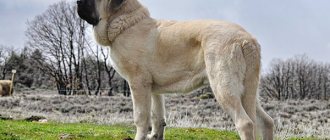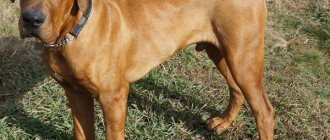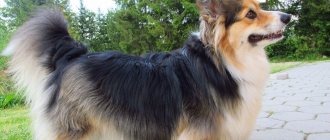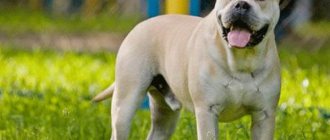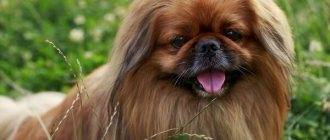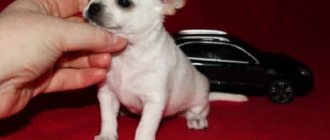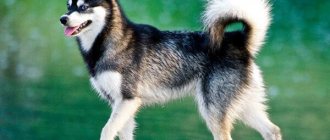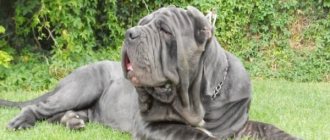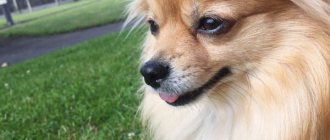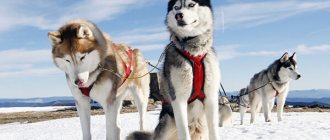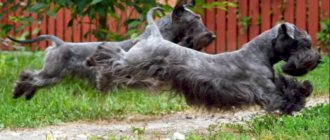The name “mastiffs” unites a large group of breeds, which includes Tibetan, English, French, Spanish, South African, Pyrenean, American, Japanese and other varieties of similar dogs.
There are many rumors about the Fila Brasileiro breed.
It is prohibited in some countries, and in others you simply cannot own a dog without a certain document.
What is special about the Brazilian Mastiff?
Why are there so many prejudices about this breed, and how true are they?
Before getting such a dog, you need to carefully understand everything so as not to be deceived and know exactly what to expect from a Brazilian Mastiff.
Care and maintenance
Fila Brasileiro is not suitable for apartment living.
Their large size and desire to patrol the area require a spacious, fenced yard. In addition, the dog reacts by barking to any suspicious movement, which will lead to conflict with neighbors. Keeping it outside means having an enclosure and an insulated booth. This breed has short hair without undercoat, so the dog needs to be moved into a house or outbuilding for the winter.
Fila does not need regular brushing. It is enough to go over the wool with a rubber mitten from time to time. Bath the dog 2-3 times a year using special shampoos. The rest of the time, it is enough to wipe it with a towel or rinse it in the shower.
Brazilians shed moderately, but due to the large size of the dog, hair will be everywhere.
Folds should be wiped regularly to avoid infection. The same goes for the ears. They get clogged with debris during walks, and their closed nature contributes to inflammation. Therefore, they need to be inspected daily and, if necessary, cleaned. This is done using a cotton pad soaked in warm water or a special lotion.
- Eyes are cleaned as needed. To do this, use a cotton swab dipped in warm water or chamomile infusion. Black tea without flavorings or additives is also suitable. Cleansing movements are directed to the corner of the eye.
- If the claws do not grind down on their own, they are trimmed twice a month.
- “Brazilians” need regular exercise. The duration of each walk should be more than half an hour.
Feeding
“Brazilians” can be fed both homemade meals and dry food. The choice of food depends on the capabilities and desires of the owner. The main thing is to stick to one type of feeding.
If the owner has chosen industrial food, it must be at least premium. Cheap “drying” provokes allergies, urolithiasis and digestive disorders. Economy class feed is made from by-products and waste from slaughterhouses. In addition, flavor enhancers are added to them, which are addictive.
Even premium food does not always live up to its name. They add offal and meat flour: whole meat is rarely used. The ideal option is super-premium drying. It contains premium meat, fresh fruits and vegetables. An additional plus is the grain-free range. The absence of grains reduces the risk of allergies.
Quality feeds include:
- Akana;
- Go;
- Orijen;
- Now Fresh;
- Belcando;
- Grandorf;
- Wulfsblatt;
- Bosch;
- Eukanuba;
- Hills.
The recommended serving size is indicated on the packaging or the manufacturer's website.
If the owner is a supporter of “natural food”, he should include the following products in the menu:
- raw lean meat (beef, horse meat, rabbit and lamb);
- boiled poultry;
- well-cooked offal (heart, lung, kidneys);
- raw lamb tripe;
- raw cartilage;
- meat broths;
- raw or boiled sea fish (limited);
- fish fat;
- cereals (rice, buckwheat, oatmeal);
- raw chicken or quail yolk (no more than twice a week);
- boiled egg white;
- fermented milk products (cottage cheese, kefir, yogurt);
- fresh or stewed vegetables (except cabbage and legumes);
- a clove of garlic (once a week to prevent helminthiasis);
- seasonal fruits and dried fruits (except exotic types);
- fresh herbs (parsley, dill, green salad);
- vegetable oil (teaspoon per day).
Meat should make up up to half of the daily diet. It is given raw, scalded with boiling water. To avoid infection with worms, the meat is stored in the freezer for several days and thawed several hours before serving.
Due to the low energy value, the “fish” portion is doubled (the same applies to offal). The head, fins, entrails, bones and tail are removed from the fish.
Dairy products replace a full meal. They are offered as a snack.
List of prohibited products:
- pork;
- milk (not absorbed by the body of an adult dog);
- boiled bones;
- poultry tubular bones;
- potato;
- cabbage;
- legumes;
- grapes and raisins;
- soy;
- fresh bread and products made from yeast flour;
- smoked meats and sausages;
- confectionery;
- fried, salty, spicy, fatty;
- seasonings and spices.
Regardless of the type of food, the Fila should have constant access to fresh water.
Content requirements
Representatives of the breed are quite large and tall; keeping such a dog in an apartment is not the best idea. The dog needs a spacious yard where he can run around and stretch his paws. In an apartment building with such a dog, it will not be easy for the owner - the “Brazilian” will greet every passerby who gets in his way with barking and roaring. People intolerant of animals and families with small children are unlikely to be happy in the neighborhood of such a beast.
Optimal conditions of detention
Space and freedom are necessary conditions for a dog. A private house outside the city with a large area and a high fence is an ideal option for keeping a pet. It is advisable that there are no other houses or animals nearby. Fila reacts to any noise with a loud bark, so neighbors who love peace and quiet will not be happy about such an inhabitant nearby.
Fillet needs regular physical activity and long daily walks - at least 1 hour per day. It is advisable to walk the dog in a specially equipped stadium, and in no case near a children's playground.
On the territory of the house, the dog can be kept in a kennel or enclosure, but not permanently, otherwise the animal will grow even more aggressive. In winter, it is better to move the dog indoors - these pets do not like the cold and do not tolerate it well due to their short hair.
Hygiene and care
Caring for the “Brazilian” does not cause any inconvenience to the owners. The coat should be brushed regularly, but not every day, with a special short-toothed brush. The dog's ears are inspected daily to detect ticks in a timely manner, and are also treated with an antiseptic solution.
Water procedures are carried out as pollution occurs, but at least 2 times a year
Paws should be washed and wiped dry after each walk, paying attention to the pads of the toes. It is necessary to accustom your dog to bathing as a puppy; it will be impossible to force an adult dog to bathe for the first time.
Every day it is necessary to examine the oral cavity, monitor the condition of the teeth, and remove food debris from the lips and gums. The eyes are wiped with a damp cotton pad moistened with clean water or chamomile decoction.
What to feed?
The ideal food for Fila is ready-made, balanced premium dry food. The package contains an optimal set of proteins, carbohydrates, vitamins and minerals that can keep your dog healthy. It is permissible to supplement the diet with natural food - lean meat, dairy products, cereals and vegetables. You should not feed your dog chocolate, candy or other sweets. There should be a bowl of clean drinking water next to the food, which needs to be changed 1-2 times a day.
The frequency of feeding an adult pet is twice a day, morning and evening. The second portion should be slightly smaller in volume to prevent overeating. Puppies are fed 5-6 times a day in the first 3 months of life, 4 times a day from 3 to 8 months, 3 times a day from 8 months to a year.
How to train?
The main goal of training a pet is to learn to obey the owner's commands and complete obedience. When the puppy has memorized his name, you can start practicing the basic commands - “lie down”, “place”, “fu”, “voice”, “come to me”, “next to me”. It is imperative to reward your pet for obedience - a small treat or praise is an incentive to remember faster.
It is necessary to teach the dog to eat strictly on command so that the dog does not pick up anything from the ground during a walk. It is also mandatory to train your pet not to hunt other animals and birds, otherwise during a walk the fila will chase the first animal it comes across.
The ideal owner for a “Brazilian” is calm, moderately strict, and always an experienced dog breeder. It is necessary to encourage your pet, but excessive affection, like screaming, is unacceptable. The dog must understand that the owner is superior to him, only then the animal will begin to obey and allow the person to dominate him.
Diseases and life expectancy
The health of the Brazilian Fila can be called strong; it is resistant to infectious diseases. With proper care and good genetics, the dog will live 10–12 years. Dogs of this breed that live up to 15 years are considered long-livers.
The Brazilian Mastiff, like most large dogs, suffers from the following diseases:
- hip dysplasia;
- volvulus (due to poor diet);
- cardiac ischemia;
- eye diseases.
History of the origin of the breed
The history of the breed begins more than 2000 BC in Israel. There is evidence that Canaanite dogs lived in the court of Queen Jezebel, who was the wife of King Ahab of Ancient Israel. This queen was distinguished by an extremely bad and cruel character, but nevertheless the dogs faithfully sat at her feet and accompanied her on walks. This once again suggests that animals love us not for our character and personal qualities, but because we simply exist in their lives.
In fact, these were ancient stray dogs. Shepherds took them with them to graze livestock and actively used them on the farm as helpers. This is how this breed successfully developed and strengthened. For both man and dog, the tandem was productive and profitable.
As time passed, a period of wars with the Romans began in Israel. People died and animals died. Fortunately, the breed was not completely exterminated, since the smartest and most adapted individuals fled away from people. In the Negev desert, for many centuries, the Canaan dog tried to survive, find food and adapt. The young animals no longer knew the person and were completely wild.
At the beginning of the twentieth century, in Palestine, famous Israeli dog breeders Rudolf Mendel and his wife were given the task of breeding a breed that would be suitable for guarding distant Jewish settlements. It had to be a healthy, hardy, strong and smart dog.
The couple remembered the wild desert dog, because it was thanks to their remarkable health and ability to adapt to difficult environmental conditions that they survived as a species. The Mendels began to re-domesticate adult dogs and select puppies. The result was a multifunctional breed that was a watchman, a shepherd, a companion, a guard, a messenger, and a sentry. Once again, the Canaan dog easily did everything that man demanded of it.
During World War II, these dogs searched for mines better than mechanical detectors. After the war, the dogs were retrained to serve as guide dogs for the visually impaired, and the breed performed this function “excellently.” Later, Canaanite occupations included search and rescue and police work. In 1953, the Israel Kennel Club registered the Canaan Dog breed. In 1992, the breed was officially recognized by the United Kennel Club, and in 1997 it was approved by the American Kennel Club (AKC).
Return to content
Historical reference
First of all, let’s dispel the misconception that the Belgian Malinois is related to France. The short-haired line of shepherd dogs was bred in the Flemish region, which is part of Belgium. Previously, before the formation of the official Dutch and German languages, French and its dialects were briefly used in the region. This is why some city names and names are written and pronounced in the French manner.
This is interesting! In 1882, one of the most influential cynological unions in Belgium, the Society of St. Hubert (SRSH), was founded.
Upon closer examination of the history of the breed, it can be assumed that the Malinois still has international roots. The notes of Louis Hugebaert (honorary member of SRSH) contain data on short-haired mestizos of the aboriginal type living on the border of the modern Netherlands and Belgium. Simply put, under the guidance of shepherds and nature, shepherd dogs were bred in a limited area through primitive selection. The dogs had a stable gene pool, were similar in appearance and fit into the primary standard of the Belgian Shepherd breed.
The similarity of the dogs was discovered by chance, during a small rural exhibition, where shepherds showed off their charges and were looking for dogs for mating. Mr. Hugebaert was present at this review, which promoted the Malinois to the title of national shepherd. At first, the breeding club was nothing more than a group of enthusiasts who appreciated the abilities of four-legged animals. To the surprise of people, the breed quickly stabilized and was successfully bred.
This is interesting! The name Malinois came into use 20 years after the start of breeding work.
By 1898, breeders founded the first official Malinois club, which became part of the Belgian Shepherd Cynological Union. Three years later, a male named Vos des Polders was entered into the stud book. Red dogs were often called Vos, which means Fox; the most famous shepherd dogs were:
- Vos des Polders is the first registered Malinois.
- Vos I and Vos are the ancestor and champion of Laekenois.
- Vos de Laeken - brother of Liske de Laeken and also the ancestor of Laekenois (exact pedigree unknown).
Using existing dogs and involving in breeding work producers with good conformation, but without documents, the breeders went the following way:
- From the mating of Vos des Polders and a female from the Liske de Laeken litter, Dewet was born - a stately male, with beautiful deer hair and a black mask, the first “fundamental sire” of the breed.
- During the same period of time, the ancestor Diane was obtained from the mating of Vos I and Liske.
- In turn, from mating with Samlo, Diane gave birth to a wire-haired male, Tomy (Laekenois). Samlo is registered as a shepherd of unknown origin with a brown-red color, black mask and excellent working qualities.
- Cora I, a female of unknown origin, of suitable color and conformation, was bred to Tomy, resulting in Tjop, the second male who became the origin of many Malinois lines.
Today, the working skills and characteristics of the breed allow the Malinois to be used in all special services. “Belgians” take first place in tests, serve in the army and police, search for people and chemicals, and work as guides. Frankly speaking, the Malinois is actively replacing the German Shepherd even in Germany.
History of origin of the breed
The appearance of mastiff-type dogs in South America dates back to the 16th-18th centuries. It is associated with the arrival of Spanish and Portuguese conquistadors in Brazil, who brought their Molossians to the continent, which, mixed with local dogs, gave rise to the Fila Brasileiro breed at the end of the 19th century.
There are several versions of the appearance of the Fila Brasileiro breed.
The first version claims that the Fila appeared as a result of crossing a mastiff, a bloodhound and an English bulldog. From the mastiff, the Fila inherited the shape of the skull and back, from the bloodhound it borrowed the hanging folds of skin, a sad look and a keen sense of smell, and from the ancient bulldog breed it inherited a violent temperament and stubborn disposition.
Another hypothesis states that the Fila traces its ancestry to the Fila Terceirense (a breed named after the island of Terceira, part of the Azores Islands). With the accession of King Don Joan VI to the Brazilian throne, the English mastiff, popular in those years, began to be imported to Brazil. Due to random crossings, a cross between the Fila Terceirense and the Mastiff appears.
It is possible that the Fila Brasileiro breed was formed from a cross between the ancient English mastiff, the Bullenbeiser (an old-type bulldog) and a descendant of St. Hubert's dog (the "bloody bloodhound").
The dog was used not only to guard haciendas and plantations, work on ranches and hunt panthers and jaguars, but also to capture runaway slaves. They were also used to escort slaves deep into the continent.
In 1815, Portugal and Brazil were declared a single state. Most likely, during this period there was an active crossbreeding of Portuguese dogs (apparently, they left the Fila Brasileiro “crooked tail” as a legacy) with herding and castle-guarding dogs. This period causes the most heated debate among Brazilian breeders of the Fila Brasileiro.
In 1938, a common passion and love for this breed united its admirers and connoisseurs into a national congress headquartered in Rio de Janeiro. They were all driven by a passion to improve the breed. Eventually, as a result of crossing several breeds over several centuries without the intervention of specialists, a new breed emerged.
The first reference sample was selected from a large number of applicants in 1946. The Fila Brasileiro was recognized as an independent breed in 1950.
In 1976, a new version of the breed was developed, more “detailed”, but without the specific features characteristic of a particular breed.
Fila Brasileiro appeared in Russia in 1992, when the male Alaketus Dardo and the female Alaketus Ingrid were brought from the Brazilian nursery Alaketus. Subsequently, they and their descendants became the founders of many Russian nurseries.
In the UK, Israel and Norway, ownership of Fila Brasileiro is prohibited without a special court order. In some Australian states, ownership of fila is prohibited or restricted, and import is prohibited. In New Zealand, Filas are automatically classified as dangerous dogs, which means import bans and males are neutered. Also, dogs of this breed are prohibited from being imported into the Republic of Cyprus.
How to choose a puppy
A Fila Brasileiro puppy will charm you at first sight, but being touched by this charming creature is by no means a reason for spontaneously purchasing such a dog. Once again, weigh all the pros and cons - decide: are you ready to work hard so that the huge potential inherent in the baby’s genes is revealed correctly and does not cause trouble? If you really feel strong and persistent enough, get a Brazilian Mastiff. You will never regret it and will get a lot of pleasure from communicating with this amazing dog.
Brazilian Mastiff puppies - a gang of cheerful hooligans
Despite its rapidly growing popularity, the breed remains rare and expensive, with a puppy costing between one thousand and two thousand dollars. It is advisable to immediately assess your ambitions and capabilities: whether you want to buy a show dog or just a reliable friend. This decision will determine not only the price of the baby, but also the entire complex of his upbringing in the future - and therefore the rhythm of your life for at least the next decade.
A show-class Brazilian Mastiff puppy is expensive and is socialized from the first months of life.
The task of choosing is greatly simplified by the fact that in Russia and neighboring countries there are already quite a lot of not only Brazilian mastiffs, but also breeding kennels working with this breed. But the very first Fila was brought to Russia relatively recently - in 1992, then the Brazilian Mastiff’s path to popularity began.
So small, but already a pacer
Do not buy a dog from dubious people or resellers - there is a high risk of getting an animal with a disturbed psyche or poor health, or even a mongrel. Try not to choose a baby based on beautiful photographs, but personally come to the kennel for him: evaluate the conditions of keeping and raising him, make sure the adequacy and good health of the parents, find contact with the breeder, whose help you will need more than once, and, finally, see him, your dog. !
Two points will help you make sure of the breed of the puppy you like. Stroke it and pull the skin - kids really like this game. A real Phil should have too much skin, as if he were trying on clothes six sizes too big. Look how the baby runs: only a Brazilian mastiff can have the so-called camel gait - an amble, in which two right paws are alternately rearranged, then two left ones, and so on.
Description
Thanks to crossbreeding, this species has the body of a mastiff and the head of a bloodhound. A very dangerous breed, but nevertheless a family one. They always protect their territory and owners, and cannot stand being touched or even approached by strangers. At home they are affectionate, gentle friends, but as soon as a stranger appears, their guard instinct turns on.
Interesting fact
He fought with jaguars and pumas and emerged victorious.
Interesting fact
Due to its hostility it is banned in many countries of the world, but nevertheless quite interesting for dog breeders.
Interesting fact
There is a popular saying: “Loyal as a fila.”
Breed Features
The original purpose of the Brazilian was to catch runaway slaves in the tropical forests of South America. He would grab them by the neck or shoulders, holding them until the owner arrived. After the abolition of slavery, the guard became a guard, a hunter, and a worker.
But the past makes itself known. After a warning growl, it can unexpectedly attack guests with lightning speed.
Be careful in such situations and start educating early so that a tyrant does not grow up
When moving, move two paws on one side at the same time. Therefore, they quickly cover long distances using little energy. They need to be constantly near loved ones and are natural protectors.
Distinctive features
Head
Heavy, wide, proportional to the body. The muzzle is voluminous and deep. There is a black mask on the face.
Jaws
Wide. The teeth are strong and sharp. Scissor bite.
Ears
Large, hanging, voluminous at the base. May be black.
Eyes
Medium size, spaced far apart. Eyelids drooping. The color is yellow or dark hazel.
Torso
Massive, powerful, dense. Deep chest, prominent ribs. Muscular neck, skin hangs under the throat. The back is straight. Strong tail, medium set. Thick skin that hangs loosely.
Paws
Oval, thick pads. Dewclaws are removed. The muscles on the legs are clearly defined, smooth and parallel. The bones are strong.
Wool
Short, close-fitting, thick. The colors are yellow, ash, brindle, white with spots.
Character
They are attached to their family, with whom they have lived since puppyhood. They get along with children, but you shouldn’t let other people’s children near them. A devoted and faithful friend to his loved ones. It is difficult to get used to a new member among familiar people, and may always reject him.
Willful, stubborn. More active than most large dogs, long walks are needed. A good watchman, protector only with proper upbringing. It can become a source of trouble if training is approached unprofessionally and incorrectly.
Barks at anything it considers dangerous or alien, especially at night. The neighbors will not like living next to such a noisy tenant. The only species whose standard states intolerance to strangers. No fear, will stop at nothing to protect his family.
Does not get along with other four-legged animals if they challenge his superiority. If from childhood he grows up with other animals, then he treats them as representatives of his pack. He will emerge victorious from any fight.
Adapts perfectly to different environmental conditions. You can leave it outside at night, it won't freeze.
Description and features
The Fila Brasileiro dog has never attacked a person to injure him. Her task was to catch the fugitive, not to harm. But, over time, they began to use it for hunting, of course, not for people.
Large dimensions and a strong body allowed the animal to defeat massive tropical game, including wild boars. But searching and hunting are not the only talents of this breed. In Brazil, it is used to protect the territory. No one will pass near Fila unnoticed. She is an example of impeccable observation.
The breed was bred using the method of multi-year selection. Dogs such as the English Mastiff, the Portuguese Guard, different types of bulldogs, etc. were crossed. As a result of these experiments, not only the brave, but also the very hardy Fila Brasileiro was born.
Some farmers use it for grazing livestock and protecting it from forest predators, wolves. The dog copes with this task excellently. Not only observation, but also absolute fearlessness helps him to be an excellent watchman.
Some people mistakenly attribute excessive anger to guard and hunting dogs. In fact, they were bred solely to help people. Even when Fila tracks down a fugitive, she does not harm him, but returns him completely unharmed. Although, her combat potential cannot but amaze. Even the most angry dogs do not show aggression towards the fillet, because they feel that they will probably lose in a fight with it.
The breed has a peculiarity - it is intolerant of the touch of strangers. The animal can lie next to its owner for hours, begging for stroking, but will never allow strangers to touch it. It may even start to growl. For this reason, the Fila Brasileiro breed is banned in many countries.
Attitude towards children and pets
The dog treats children well. However, it is better not to let your pet near small children. While playing, a child may accidentally harm an animal, to which the dog will react with aggression.
Filas do not show warm feelings towards other animals. These dogs are used to being leaders, so they try to avoid other dogs on their way. In a fit of rage, the animal can even enter into a fight in which it is almost impossible for another breed to defeat the Brazilian Mastiff. Not only dogs, but also cats cannot be kept in the same area.
About training and education
Fila is a rather stubborn animal and, once you start training, can show character without following the required commands, so try to interest her with dog treats or affectionate words.
Under no circumstances should you shout at them, much less use force; remember that they are quite aggressive and can respond to your dissatisfaction with an attack. It is worth starting training with the simplest commands - “near”, “lie down”, “sit”.
Once simple commands are fully mastered, you can begin to study more complex elements.
These dogs tend to be distracted a lot during training, they really like to run aimlessly around the designated territory and carefully study everything that is happening around, so try to focus their attention on yourself as much as possible, make more movements, dress in bright clothes, speak loudly, a lot and clearly, then the result will not keep you waiting
Brazilian Bulldog
The Dogo Brasileiro (or the dogo brasileiro) comes from crossing a male bull terrier and a boxer. His creation is attributed to Pedro Pessoa Ribeiro Danta , the famous Brazilian creator of the Bull Terrier breed in the 60s and 80s. However, popular history claims that it was actually Danta's neighbor who asked him to cross one of his male bull terriers with the neighbor's boxer. , so, in 1978, the first Brazilian bulldog dogs were born. It was the first dog breed from Brazil to be created in an urban environment...
Danta was left with one of the puppies born on this cross. When he noticed that the puppy was very healthy with a strong, agile and elegant body, demonstrating obedience and a predisposition to exercise, Danta decided to continue training this dog. The breeder originally christened the breed the name Bull Boxer , as a tribute to his parents.
In the twentieth century, the Bulldog of Brazil was recognized by the Brazilian Confederation of Dogs (CBKC). The breed is now getting closer and closer to FCI recognition.
Breed characteristics
The Fila Brasileiro dog has well-defined guarding, herding and hunting instincts. But, first of all, it is a guard dog, a protector.
They are loyal to their owners, love children, but children from their own family. Fila are not only reliable protectors, but also true friends and cheerful companions.
This huge dog will gently cuddle up to family members, like a small kitten, but when strangers appear, it will instantly turn into an aggressive and vicious defender.
If someone or something seems suspicious to him, he acts with lightning speed, harshly and mercilessly (included in the TOP 10 of the most evil breeds), so you should always be on the alert - you need to stop his actions before he takes them.
So, the most outstanding part of the character of the Brazilian Phil is courage, determination and exceptional courage. Fila is very obedient towards his owner and his family and is extremely tolerant of children.
He always seeks the company of his owner. One of his characteristic features is distrust towards outsiders. His calmness, equanimity, self-esteem and confidence cannot be disturbed either by unexpected noises or by new, unfamiliar surroundings.
Is it difficult to train a Fil? Much depends on the ability to show leadership in relation to a huge, powerful dog. This strong-willed breed will please the owner, provided that the owner is confident in himself, understands the dog's body language, and is able to achieve excellence in the training process. Consistency, patience and cheerful praise are a must.
Pros and cons of the breed
The Brasileiro breed is not for everyone. His owner must have an understanding of the characteristics of these formidable dogs. The main pros and cons of this type are outlined below.
Advantages:
1. Exotic appearance. 2. Friendliness towards family members. 3. Endless devotion. 4. Excellent guard and security qualities.
Chinook Health
Despite the fact that the dogs were bred to be resistant to low temperatures, they cannot boast of “Siberian” health. Either from a mixture of many bloods in the breed, or from other unknown reasons, they often suffer:
- allergies - most often it manifests itself as skin rashes and redness of the eyes;
- hip dysplasia - can be manifested by limping, difficulty getting up on their paws after sleep, can be congenital or acquired due to improper feeding or heavy loads (therefore, it is recommended to even walk puppies up to one year carefully, not to the point where the dog gets tired);
- epilepsy - a chronic disease of the nervous system, manifested by convulsive seizures;
- cryptorchidism - undescended testicle into the scrotum in male dogs.
To prevent many diseases, it is necessary to undergo regular examinations by a veterinarian, give your pet all the necessary vaccinations, and treat it against parasites.
The Chinook is a strong and hardy dog, specially bred for sled work in the North. Representatives of this breed have many advantages and only one drawback, which is the rarity of these dogs and the difficulty of purchasing a puppy. But the qualities that Chinooks possess are worthy of their growing popularity. I would like to hope that the breed will follow this path and will finally receive recognition from kennel clubs.
How long does one live and the main diseases?
This breed has good health, but there are diseases to which it is susceptible.:
- Hip and elbow dysplasia;
- Digestive problems (bloating);
- Cardiac ischemia;
- Eye diseases (“cherry eye”);
- Otitis.
On average, an animal lives 10-12 years.
Description of the breed
Externally, the Brazilian Fila looks harmonious, despite the fact that the dog has a very powerful bone structure. Dogs are very confident, react instantly and decisively, even when outwardly they look completely relaxed.
Table 1. Brazilian Fila: Breed Standard
| Characteristics | Description |
| Height | 60-75 cm depending on gender |
| Weight | Not less than 40 kg |
| Head | Pear-shaped, massive in appearance, proportional to the body |
| Muzzle | Longer than mastiffs, wide, deep, should blend harmoniously with the skull |
| Body | Massive, muscular, longer than the height of the body |
| Tail | Very long, low set, tapering towards the end |
| Wool | Short, smooth, easy to care for |
| Color | Plain, brindle. White, mouse-colored fur, inclusions of spots are not allowed |
Brazilian Fila dog
Pet standard
The International Canine Standard specifies all the necessary signs and characteristics of the Brazilian Mastiff: body build, color, structure of body parts and character. According to the description, this is a Molosser with large bones and a harmonious body build.
The standard specifies the two most important characteristics of Fila Brasileiro:
- The skull is longer than the muzzle;
- The length of the body should be longer by 10% of the dog's height.
The head is massive, with a wide skull, the upper lip covers the lower lip, and is in a drooping state. The forelimbs are more powerful than the hind limbs, the skin hangs freely. The coat is short.
The standard also indicates shortcomings and defects . Some of them include a short muzzle, too light eyes, a sagging or hunchbacked back, weak bones, many white spots on the coat, etc.
Appearance
The Brazilian Terrier is a slender, medium-sized dog, well-balanced, square in build, with a strong but not heavy structure. Height at the withers of males - 35-40 cm; females - 33-38 cm. Weight about 10 kg.
The head is triangular in shape, tapering noticeably from the eyes to the nose. The skull is rounded. The groove between the eyes is well developed. The stop is noticeable. The muzzle is shaped like an isosceles triangle. The nose is moderately developed with wide nostrils. The color depends on the coat. Lips are dry and tight. Complete set of teeth, scissor bite. The eyes are located midway between the occipital protuberance and the nose, set straight, round, well open, and as dark in color as possible. Already set high, tips directed towards the outer corner of the eyes.
The neck is of moderate length, well defined, dry, clean, slightly arched. The body is square and the curves are well defined. The topline is straight and firm. The withers are well defined. The back is relatively short. The loin is strong and short. The croup is slightly sloping. The chest is deep, long, reaching to the elbows. The ribs are well sprung and the underline is moderately tucked. The tail is long or short (congenital bobtail).
The limbs are thin, dry, straight and parallel.
The coat is short, smooth, and lies close to the skin. Thinner and sparse on the head, ears, neck, and the inside of the front and hind legs. The main color is white with spots of black, blue, brown or isabella. Tan markings above the eyes, on the inner edges of the ears and on the muzzle. There may be spots on light areas of the body.
Description of the external features of Fila Brasileiro
- The head
is perhaps the most defining characteristic of the breed. Although the dog is heavy and massive, the head should always remain proportional to the size of the dog's body. When viewed from above, it looks pear-shaped. - The muzzle
of the fila brasileiro is significantly longer than that of other mastiff type dogs and should be the same length as the skull or slightly shorter. It is strong, broad and deep (always in harmony with the skull), full under the eyes, tapering slightly towards the middle and widening until it reaches the frontal curve. From a side view, the bridge of the nose is straight or with a slight hump. The bridge of the nose is closely perpendicular to the top line. The upper lips are voluminous and pendular, forming a perfect curve, falling above the lower ones. The labial margin is shaped like an inverted and deep U. - The nose
is large, black with well-developed nostrils. - eyes
range from medium to large in size, almond-shaped, and colored to match the dog's coat color. The general expression of the eyes is one of the distinguishing characteristics of the breed. When dogs are at rest, they should look calm, noble, confident, but not boring. When alert, they show determination, firmness and cruelty. - The ears
are hanging, large, thick, v-shaped, wide at the base, tapering strongly towards the end. They should be close to the sides of the head or slightly tilted back. - The neck
of the Brazilian Mastiff is powerful with dewlap. - The body
is noticeably longer from the base of the neck to the croup than its height parameters, by about 10%. This breed is very powerful and extremely muscular. - The tail
of the Fila Brasileiro is long, usually with a low curve. It is very thick at the base but tapers sharply towards the end. - Limbs
with large bones and powerful muscles. - The paws
are large, with dense pads. - The coat
is short, smooth, thick and close-fitting. - The
Fila Brasileiro is allowed to be any solid color except white and mouse. These colors may or may not be very saturated. Spotted, black or tan dogs are not allowed. Black masks are acceptable for any color. White markings are only allowed on the paws, chest and tip of the tail.
Coat type and color
The key point in describing the Belgian Shepherd breed is the length and color of the coat. It was according to these indicators that dogs were initially divided into lines. The Malinois is a short-haired shepherd dog with a well-developed dense undercoat. The coat should protect the dog from moisture. The guard hair is of medium hardness, tightly fitting. On the tail and riding breeches, a not lush pile is formed.
The color is red, not intense and not lightened; the color is usually called fawn or warm. There are black marks on the shoulder blades and sides, as if the dog had been smeared with coal. On the muzzle there is a coal-black mask covering the area from the lips to the eye sockets. The ears are also black.
Dog names
If the purchase of the puppy was not planned in advance, that is, you did not agree on the upcoming litter, then most likely you will be given documents along with the puppy, where his name will already be indicated. Otherwise, you will have the opportunity to choose your own name for your future pet. It is better if it is a name that emphasizes the power and intelligence of the dog.
Try not to give nicknames that sound like teams or human names. In this case, the dog will get confused and take a long time to get used to its nickname, or respond to the call of passers-by.
Examples of nicknames suitable for Phil:
- for males - Bronko, Klim, Dovlad, Bishka, Boston, Zorli;
- for bitches – Ressi, Di-di, Pilet, Agen, Marley, Alania.
Training
Cleverness and intelligence are some of the character traits of the Brazilian Fila. The dog quickly undergoes training and always knows what is required of it. To understand the life principle of this breed, you just need to take into account that the Fila follows the pack principle, where the main one is the leader, to whom everyone obeys. Accordingly, you need to be a leader, otherwise the dog will dominate and show aggression.
Initially, Brazilian filas were used to hunt dangerous predators
The Brazilian Fila was bred to guard and hunt a large predator - the jaguar. Dogs of this breed have a strong temperament, a complex character, and require respectful treatment. To properly train this breed you need to have a lot of experience and know everything about the dog and its nervous system. Early socialization is mandatory for the Fila to avoid conflicts on walks with other dogs. When walking, it is not advisable to let the Fila off the leash, and you should not encourage hunting instincts if the owner does not have the opportunity to take the dog hunting.
Fila dogs are vulnerable, so there is no need to use physical force if the dog does not follow a command. It is better to use other methods, for example, encouragement, and then his character will be more balanced and calm. The Brazilian Fila is a devoted friend and, above all, your personal guard, so the dog loves to spend time in the company of its owner for days, no matter how much you resist it.
Despite their tough character, Brazilian Phils are very vulnerable
Russian nurseries
There are few good nurseries of the Brazilian Fila breed in Russia. It is important to choose a dog from a responsible and honest breeder, then there will be no doubt about the purity and quality of your dog’s breed.
Nurseries of the Brazilian Fila:
- Eden De Sol, Moscow;
- Rey`s Pride, Moscow;
- "Imperio Dorado", Moscow.
Purchasing a puppy
Before buying a Brazilian Fila puppy, you need to evaluate your capabilities in providing the pet with plenty of space and proper attention, since the dog is very large and active, with a complex character. Also, this breed does not like to be silent, and regular barking can tire you and disturb the peace of your neighbors. Fila loves long and frequent walks, so it is better to keep the pet in a private house with an enclosure.
In Russia there are very few good nurseries with pure breeds of Brazilian Fila. It is worth making a considerable effort to find an experienced and responsible breeder. On average, the price for Brazilian Fil puppies is from 30,000 rubles.
Buy a puppy only from specialized nurseries, having first studied detailed information about the breeder. Never buy a puppy from private individuals on the Internet.
How and what to feed?
In order for a dog to grow healthy and develop properly, it needs to be provided with proper, balanced nutrition, including the required amount of proteins, fats, carbohydrates, vitamins and minerals.
The diet of Spanish mastiffs can be based on both natural products and industrial feeds, the main thing is not to mix both types of food, as this can lead to problems with the gastrointestinal tract and cause an excess or deficiency of minerals.
Each type of nutrition has its own advantages and disadvantages.
Thus, a natural diet is varied and eliminates the possibility that the dog will get bored with food. In addition, all products included in the dog’s menu will be fresh and of high quality, since their choice is the responsibility of the mastiff owner.
Also, with a natural diet, all nutrients and minerals are better absorbed, and if an allergic reaction occurs, there is no need to completely change the dog’s diet; it is enough to eliminate the product that provoked it.
But such nutrition has significant disadvantages - it requires certain knowledge about preparing a diet and quite a lot of time preparing food for the dog.
Industrial feeds have a balanced composition and are enriched with essential vitamins and minerals. In addition, manufacturers have developed special lines of food that take into account the age, health status and activity level of dogs.
The finished product is easy to use and dose, it has a long shelf life and saves time on food preparation.
When choosing food for Spanish mastiffs, you should give preference to premium or super premium products. The most popular food brands are Brit Premium, Brit Care, Flatazor, Acana, Royal Canin.
Hovawart care
In general, the Hovawart is suitable for keeping in an apartment, but it needs a lot of space to move. Here, at least, the dog’s protective instinct can be realized, because there is a specific owner’s territory that can be walked around. In such conditions, the Hovawart will need to be walked for many hours every day, so that walks will literally bring him to exhaustion. Of course, it is difficult for the average owner to fulfill this requirement.
In this regard, an enclosure will also not satisfy the dog’s needs, even if you walk it for at least 2 hours in the open air. The Hovawart is absolutely not suitable for keeping on a chain. Here, not only physical activity will suffer, but also the animal’s psyche.
The dog is ideal for a private yard, where it will fully demonstrate its breed's protective qualities, having room for free movement and constant walking around the entrusted territory. But the owner must provide this territory with a high fence: the Hovawart jumps well and quickly attacks the intruder without waiting for the owner’s command.
A private yard with a high fence is an ideal place to keep a Hovawart.
Wool
At first glance at the long wavy coat of the Hovawart, it seems that it is precisely this that requires constant care. But that's not true. The dog's fur has water-repellent properties and practically does not get dirty. Therefore, Hovawarts are bathed 3-4 times a year, or as they become dirty, if the fur begins to give off an unpleasant odor.
But you need to comb your pet 1-2 times a week to prevent the formation of tangles. During the molting period, this procedure is performed daily.
Claws, ears and teeth
Unlike fur, claws, ears and teeth require more attention from the Hovawart owner.
The dog’s teeth are brushed, like other breeds, once every 7–10 days. To do this, use a special brush and paste.
A working dog does not need to trim its nails; they wear down naturally. They are only regularly inspected for chips and cracks. For domestic (and even more so for exhibition) specimens, the procedure is carried out once every 2 weeks. It is better to accustom the Hovawart to trimming its claws from puppyhood, then the procedure will be accepted by the pet calmly.
Once every 2 weeks, the pet’s ears are also cleaned. They are also checked for parasites. Thus, an unpleasant odor or discharge should prompt you to consult a veterinarian.
Nutrition
The young Hovawart dog is growing at a rapid pace. In addition, dogs of this breed are generally very active, therefore, nutrition should provide them with building material for muscles and bones, and the necessary energy.
Breeders recommend feeding Hovawarts with dry food. It should be at least premium class, ideally super premium or holistic. Such nutrition will provide all the body's needs; additional vitamin and mineral supplements are not required.
Hovawarts do not have a breed tendency to allergies or digestive disorders, so the owner can choose food depending on the pet’s own capabilities and preferences. But dogs of this breed are food lovers, so the owner should strictly follow the recommendations of the food manufacturers.
The following are suitable for feeding the Hovawart:
- Acana;
- Almo Nature Holistic Adult Dog Large;
- Barking Heads;
- Orijen;
- Pronature Original.
With natural nutrition, the owner will have to balance the diet himself and add vitamin and mineral components to it. Here it is better to consult a veterinarian.
In general, feeding Hovawarts does not differ from the diet of dogs of other large breeds:
- The basis of the menu should be lean meat (2/3 of the diet), the rest (1/3) should be plant foods.
- The meat must first be frozen. The fish is cleaned of bones.
- Fruits and vegetables are finely chopped, after removing tops and seeds. They can be given raw or cooked (stewed).
Not suitable for feeding:
- cabbage, potatoes, legumes;
- fatty meat or fish;
- sweets, confectionery, chocolate;
- food with added salt and spices, spicy and smoked.
Like other dogs, the Hovawart needs clean, free access to water. Breeders even recommend taking water with you on walks so that an active dog can satisfy its thirst.
Care and training
The Fila Brasileiro's coat is very short by nature, which reduces grooming to a minimum. The coat is soft and smooth, thick and therefore extremely resistant to bad weather. This coat will protect the dog well from heat and sunlight. The color of a pet can be very different, always solid, but white, mousey or spotted color is not allowed.
This breed's coat can be brushed a couple of times a week, or the dog can be rubbed with a rubber glove to remove shedding and dead hair. Bathe your animal, but do it as little as possible. Due to the short coat, do not keep the Fil in a draft or cold.
It is necessary to train and raise your pet from early childhood. The dog requires full socialization and obedience lessons, which should be repeated regularly throughout the pet's life. Due to the size of the dog, it is very difficult to control, so the owner must be very persistent and strict in order to raise a disciplined and obedient pet.
The Fila Brasileiro breed constantly needs daily activity. If you do not have livestock and a farm, you must have a yard in which the dog can perform its direct functions inherent in nature, for example, guarding the territory. Phil needs to be walked and exercised every day. In addition, the animal must be let off the leash so that the dog itself can stretch its muscles.
Character and temperament
It is believed that Fila is one of the few dogs with such strong aggression. And for good reason, in some countries this breed is prohibited. The fact is that these animals have a very strong guard instinct. They will protect their loved ones and their territory at any cost. You can't just walk up and pet this dog. He behaves with strangers no worse than a wolf. However, it is worth noting that these dogs are very family-oriented. In terms of their behavior in the house, they can resemble a cat that will follow you and pet you. They are very attached to their family, get along with children and are able to tolerate all children's fun. However, under no circumstances should other people's children be allowed near the fillet. It is very dangerous. They are extremely vicious dogs to outsiders. And they are very affectionate, gentle and sensitive to loved ones. These are very devoted and faithful friends who always feel what you need at the moment.
Owner reviews
Breeders and owners consider the Brazilian Fila an ideal guard dog, completely devoted to its owner, with developed watchdog qualities and a strong character. To strengthen the bond between the dog and the owner, the pet should be trained not by the dog handler, but by the owner himself, then the Fila will be less aggressive. If you neglect to raise a dog of this breed, the pet will become dangerous to others and even to the owner himself. You need to approach training wisely and have leadership qualities. In good hands, with the right upbringing, this breed will prove itself to be a devoted friend and a wonderful guard.
If properly raised, the Brazilian Fila can be a wonderful friend, protector and nanny, but you should always be careful and not leave children unattended
Nutrition
The main food product in the diet should be meat, as it contains a large amount of animal protein. Also, be sure to feed your pet vegetables, fruits and cereals, as these are the main foods containing fiber, which is necessary for good digestion. Do not forget to give your animal various vitamin and mineral complexes. Seafood, eggs, cottage cheese, fish oil, meat broth are healthy. Feed the Fila Brasileiro two or three times a day in small portions. Eliminate legumes, cabbage, pickled vegetables, smoked meats and sweets from your diet. Remember to check the water in the bowl regularly.
